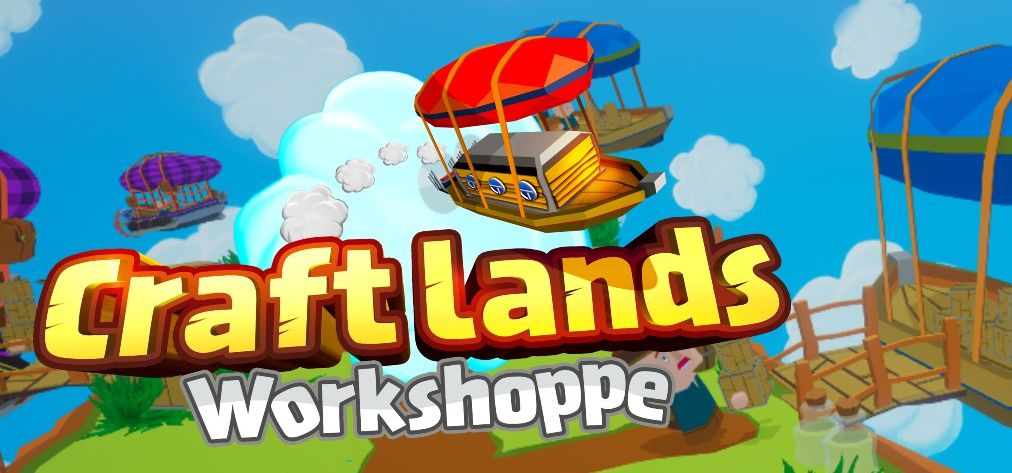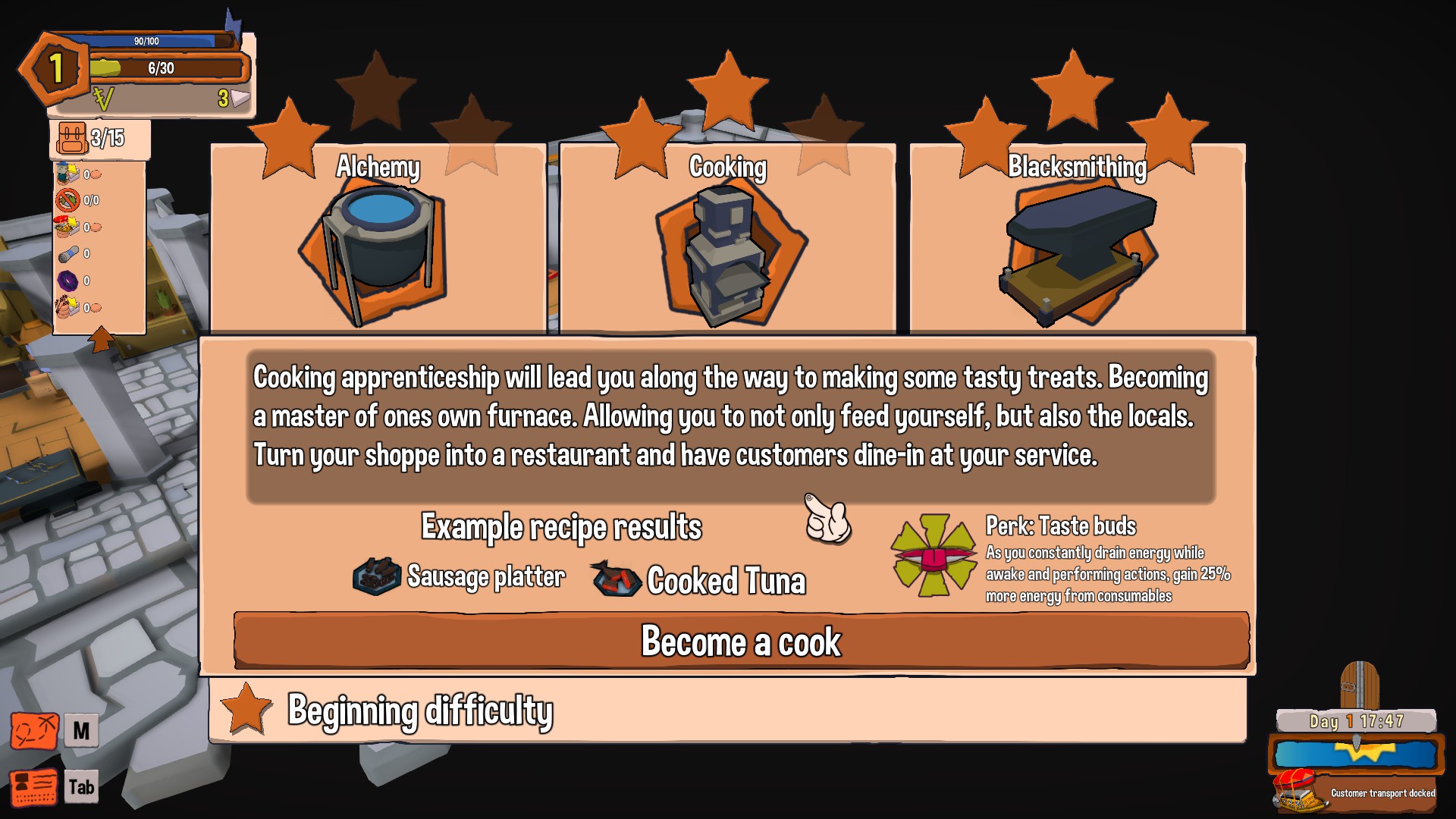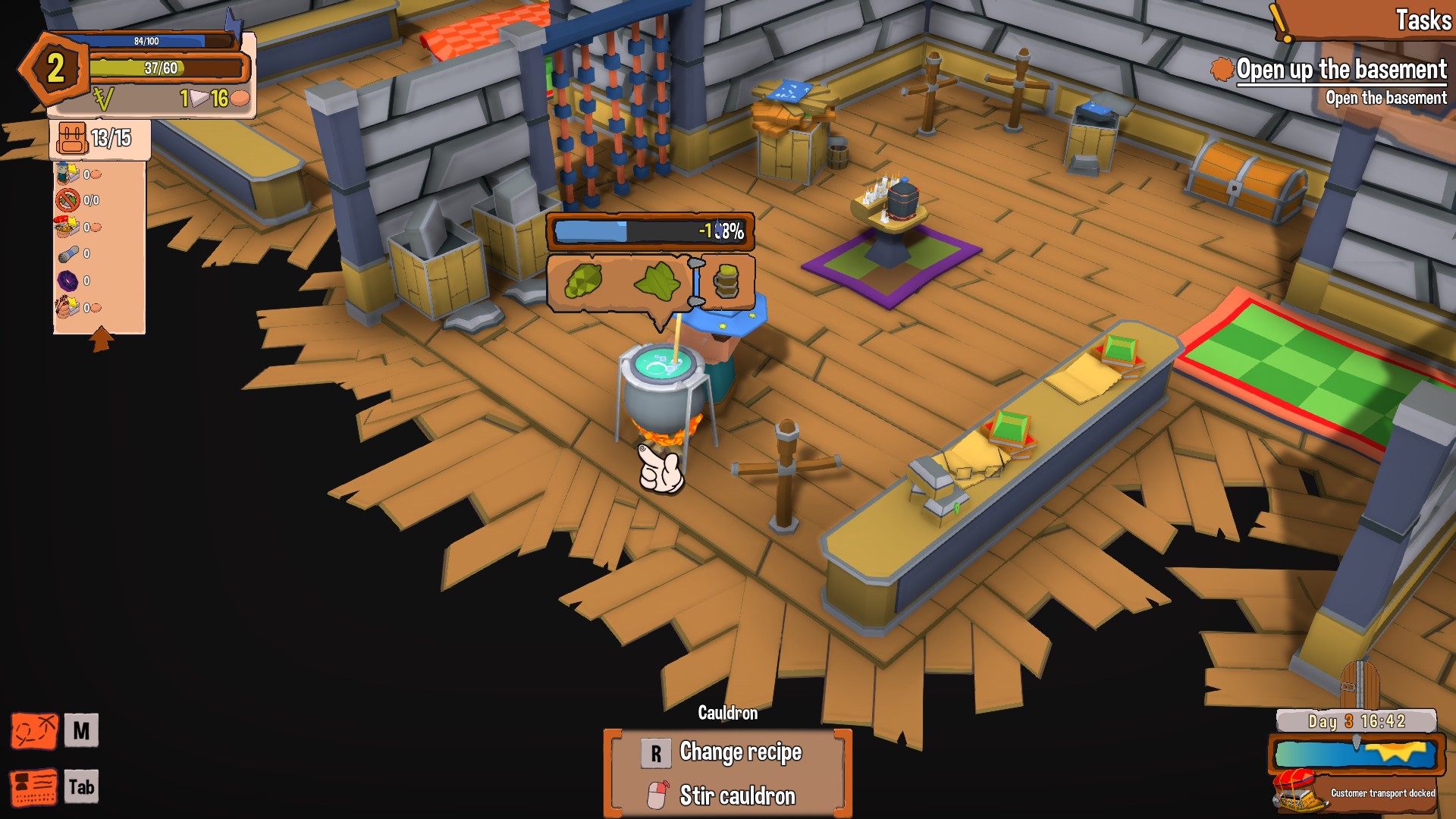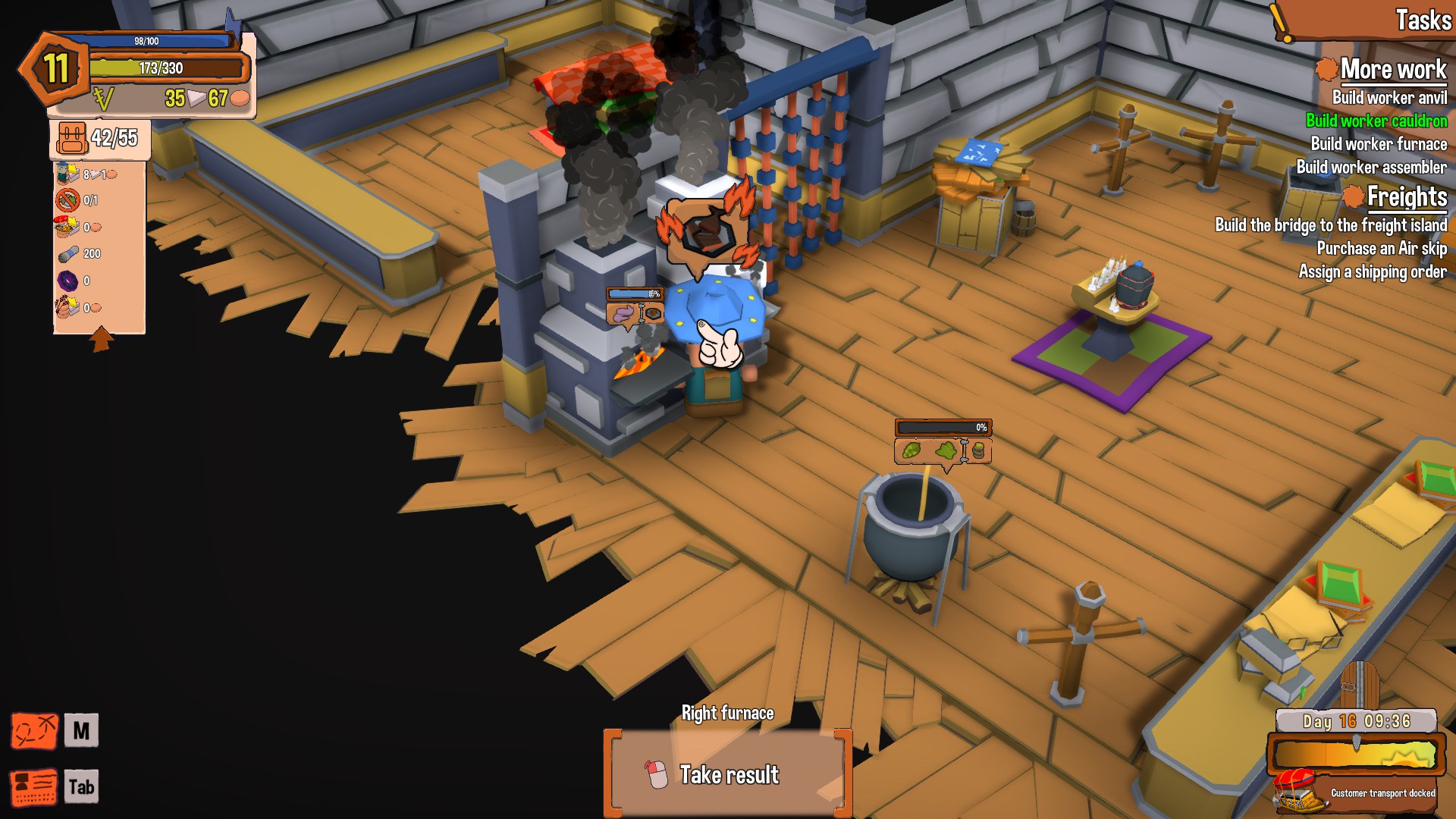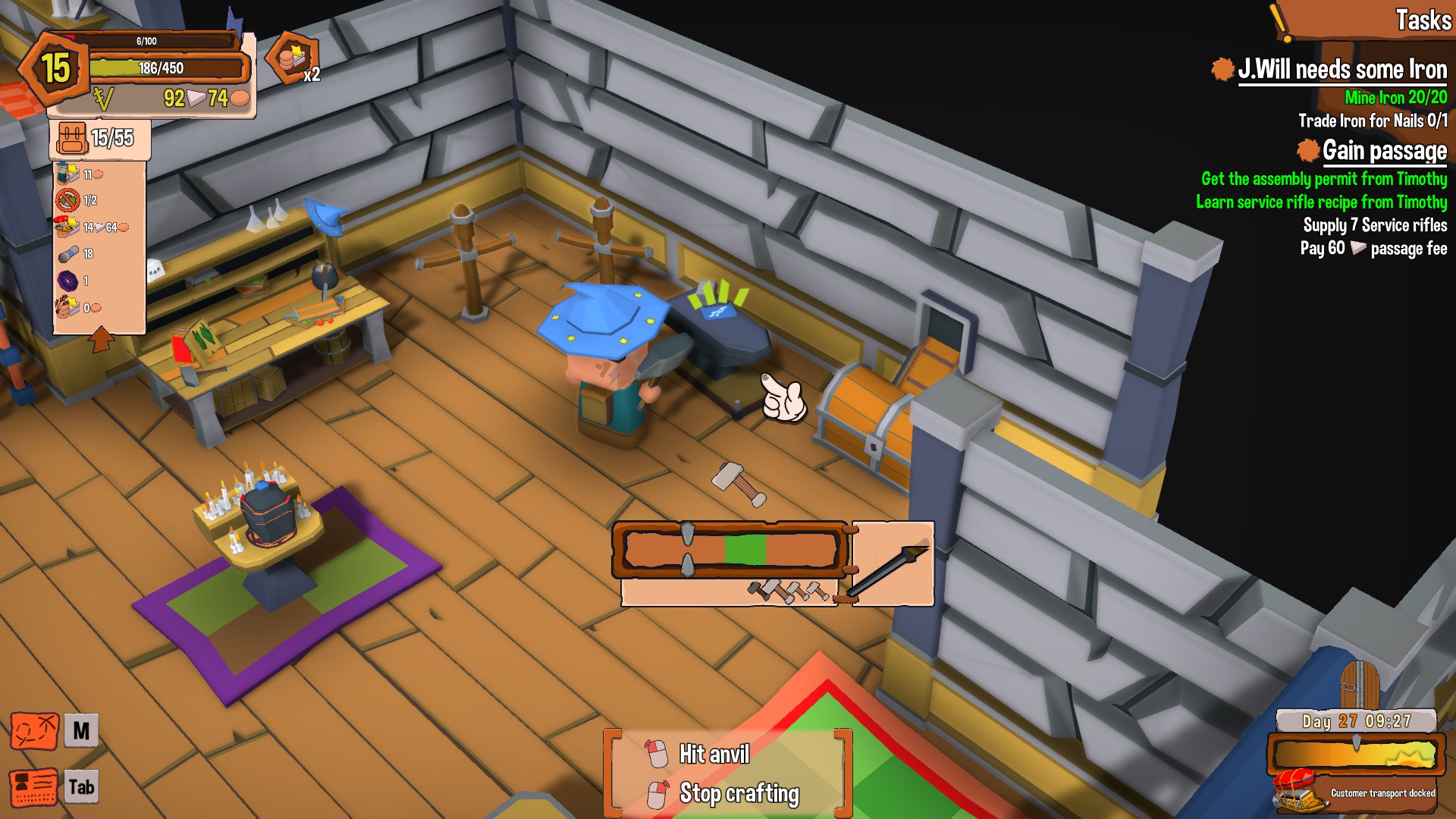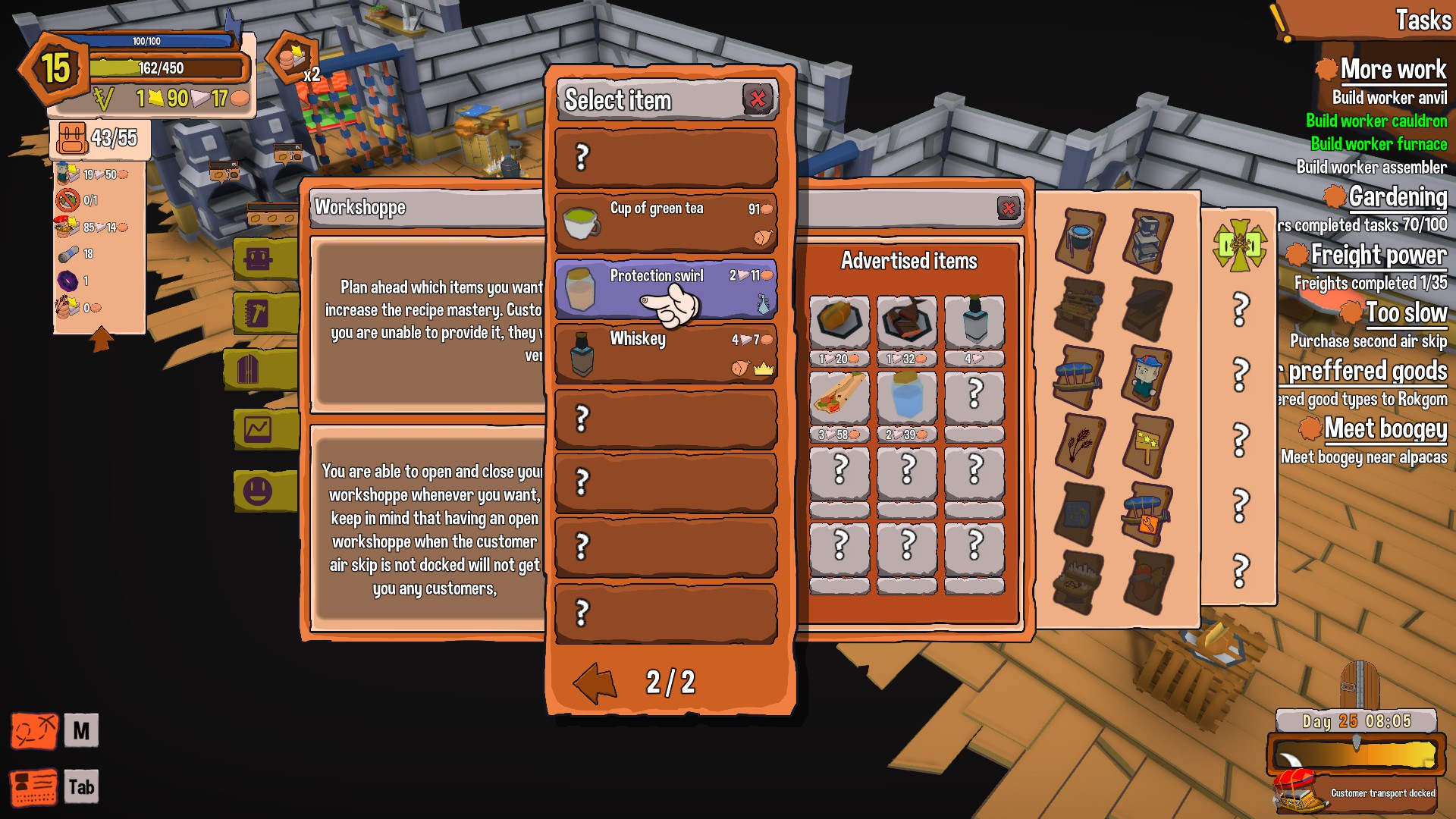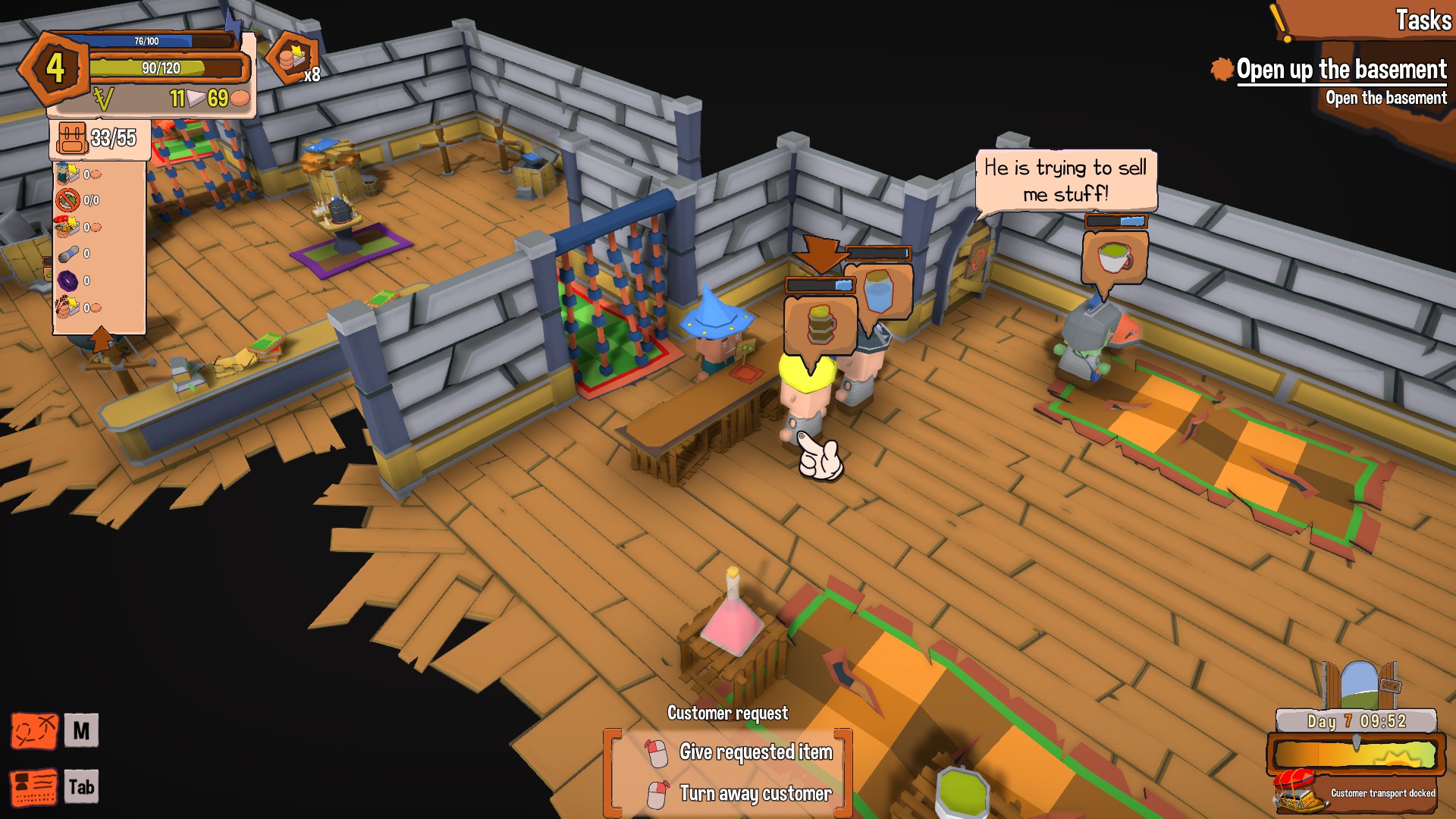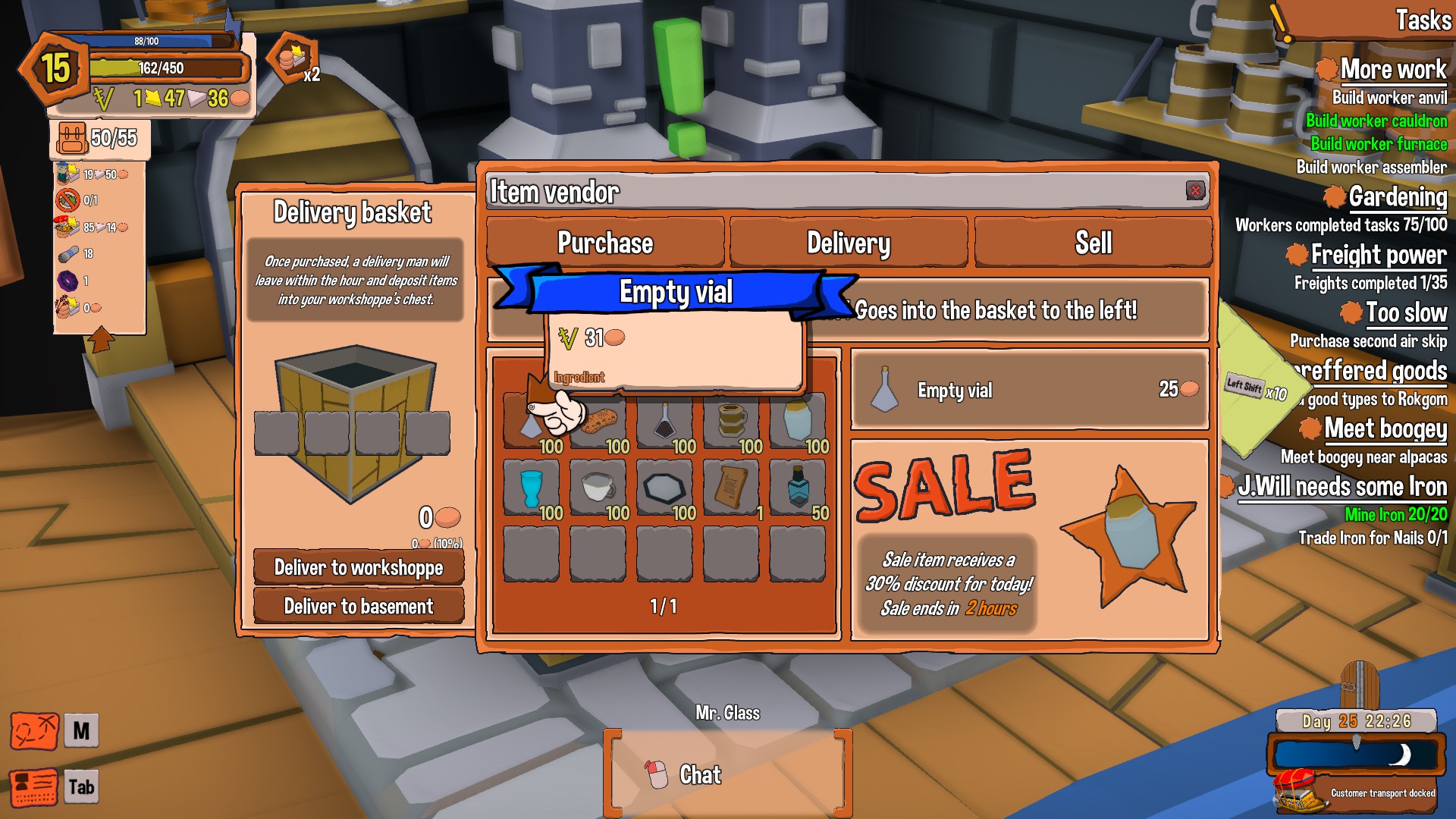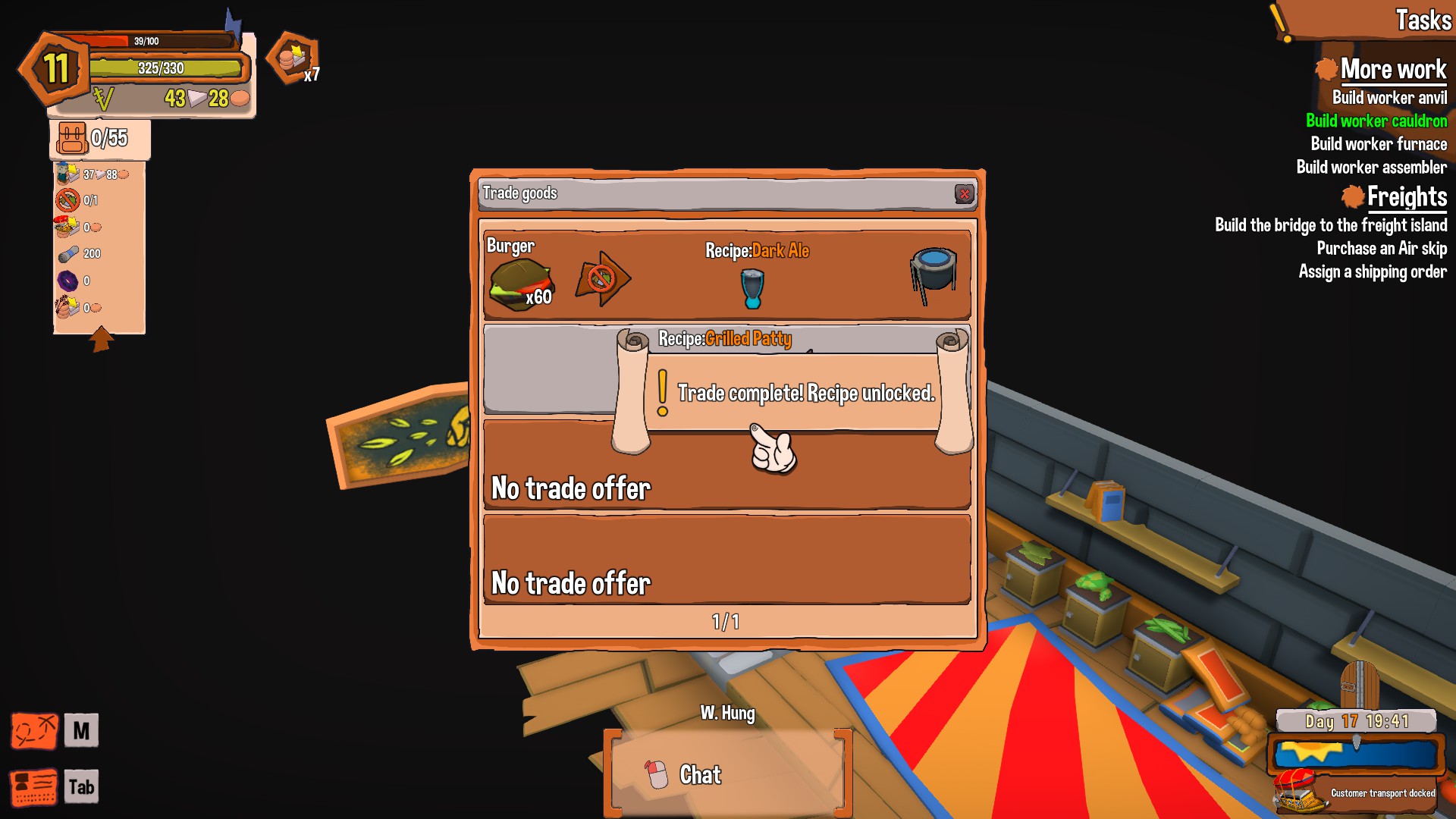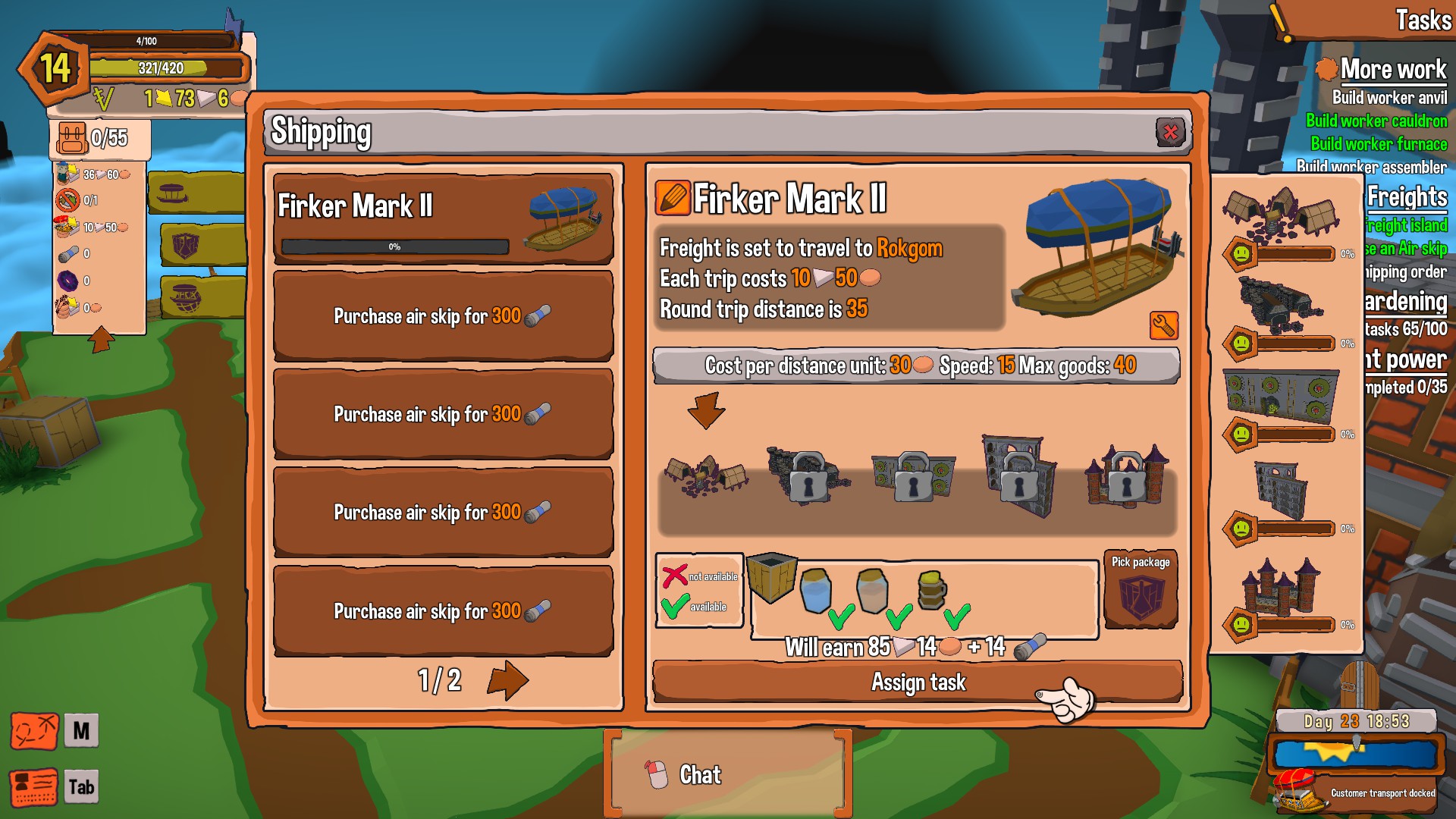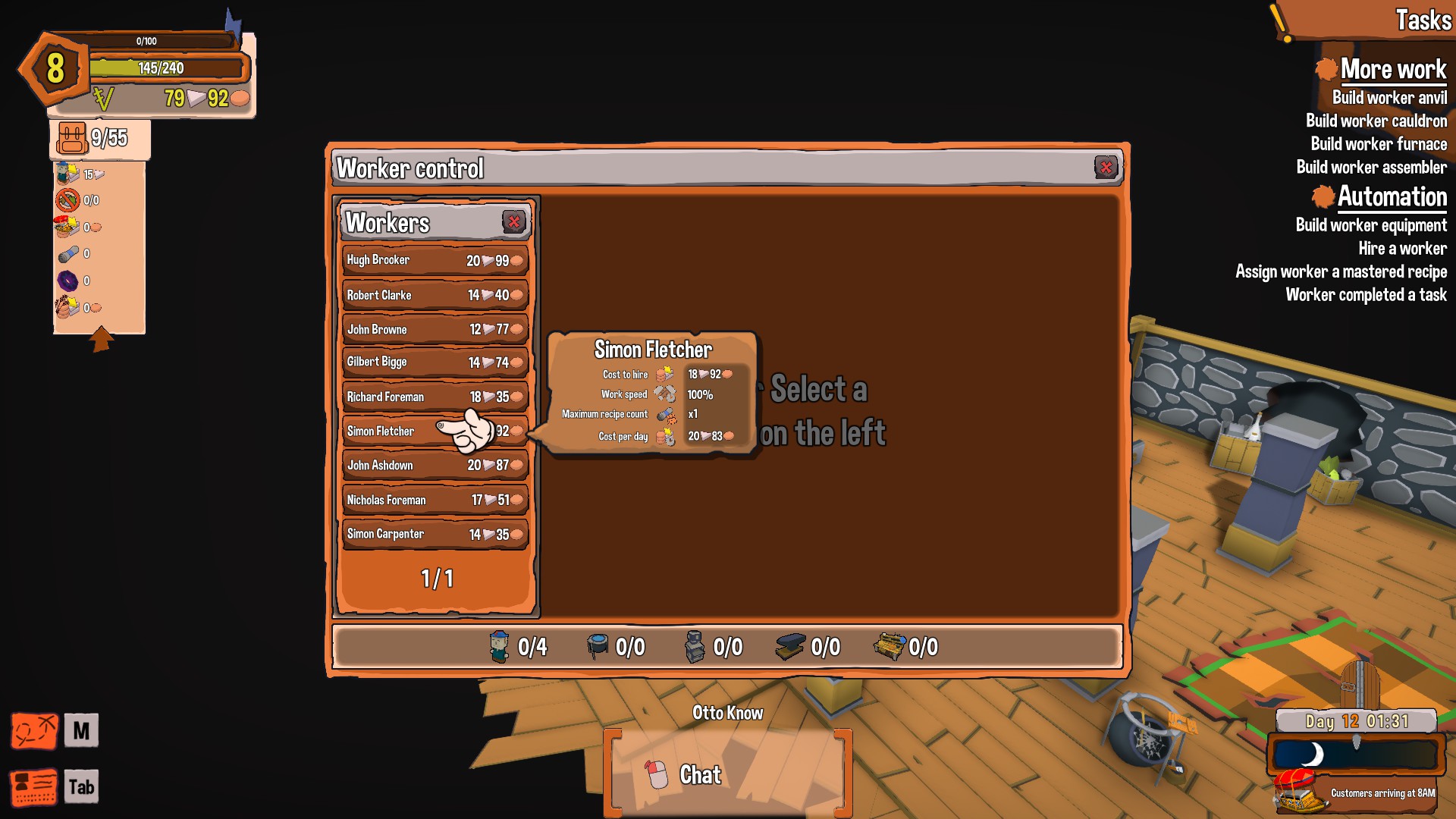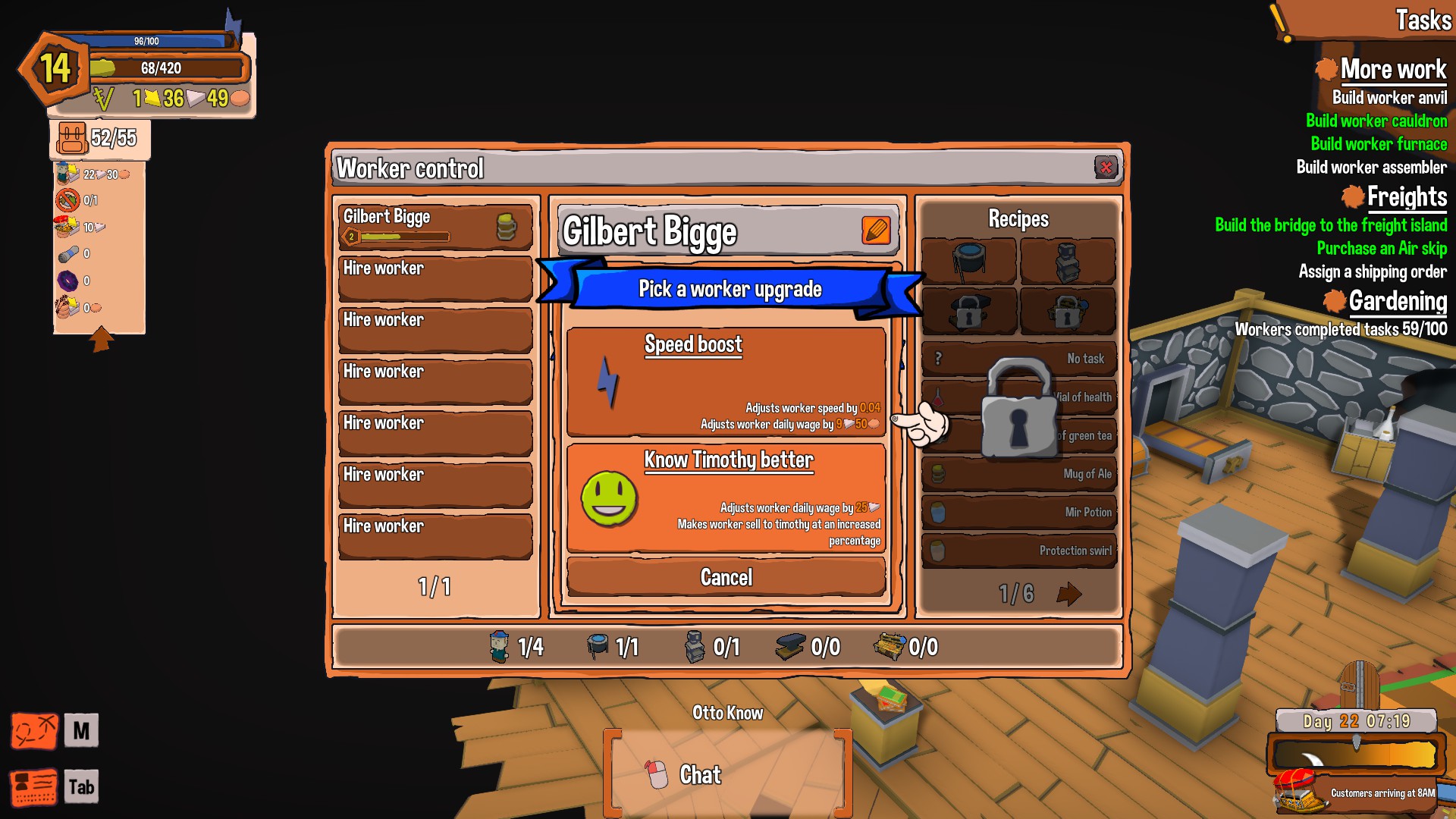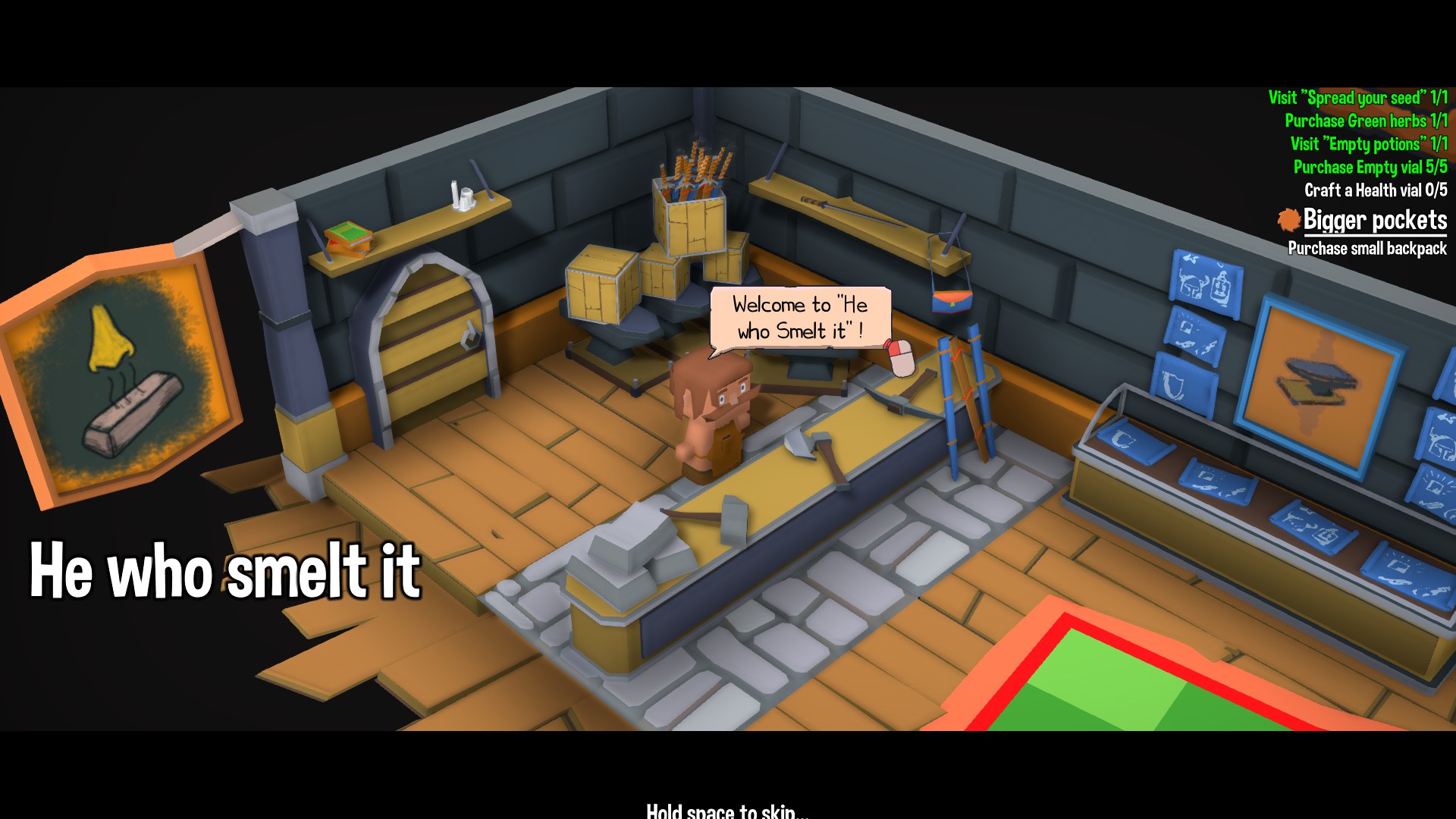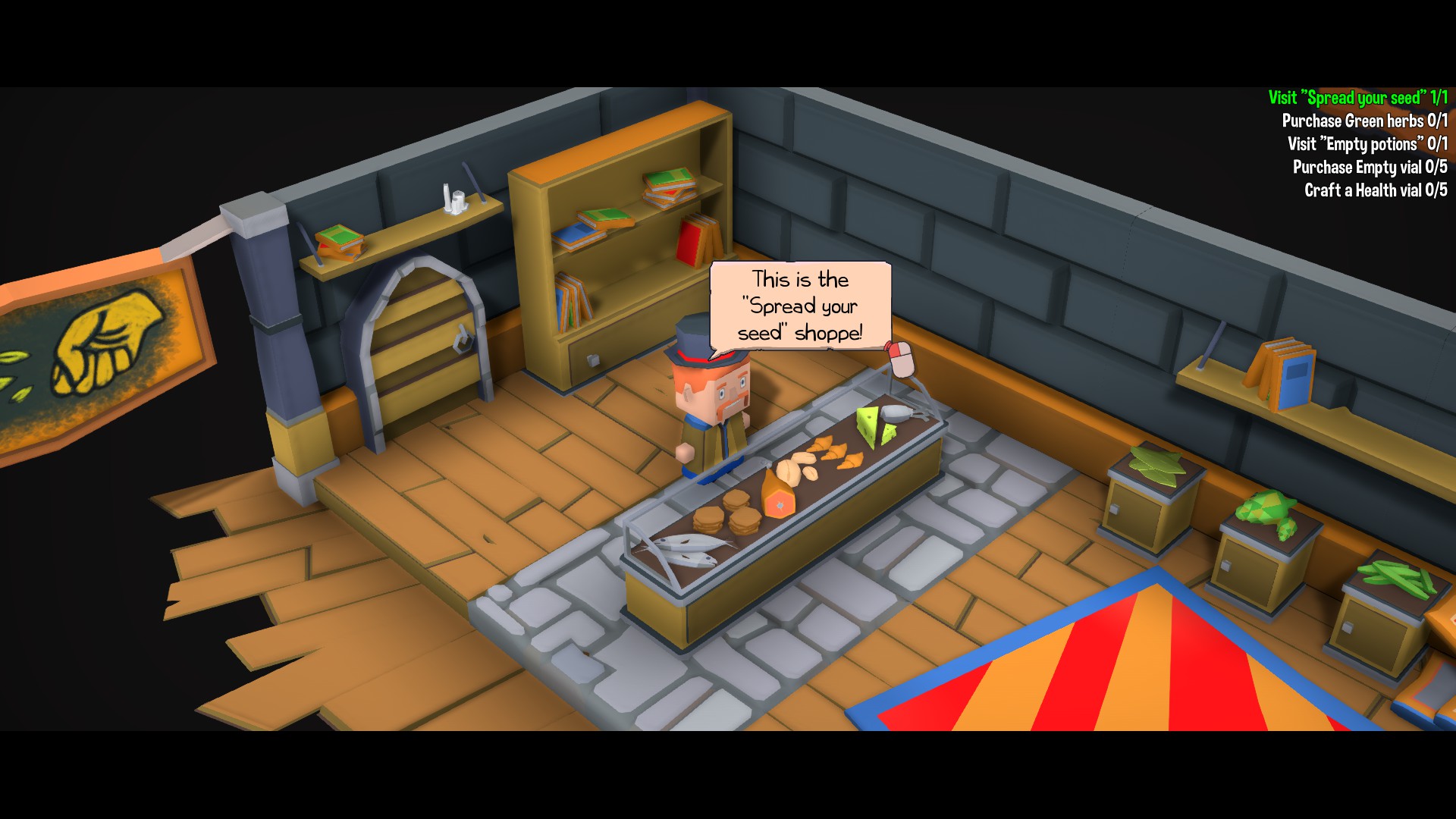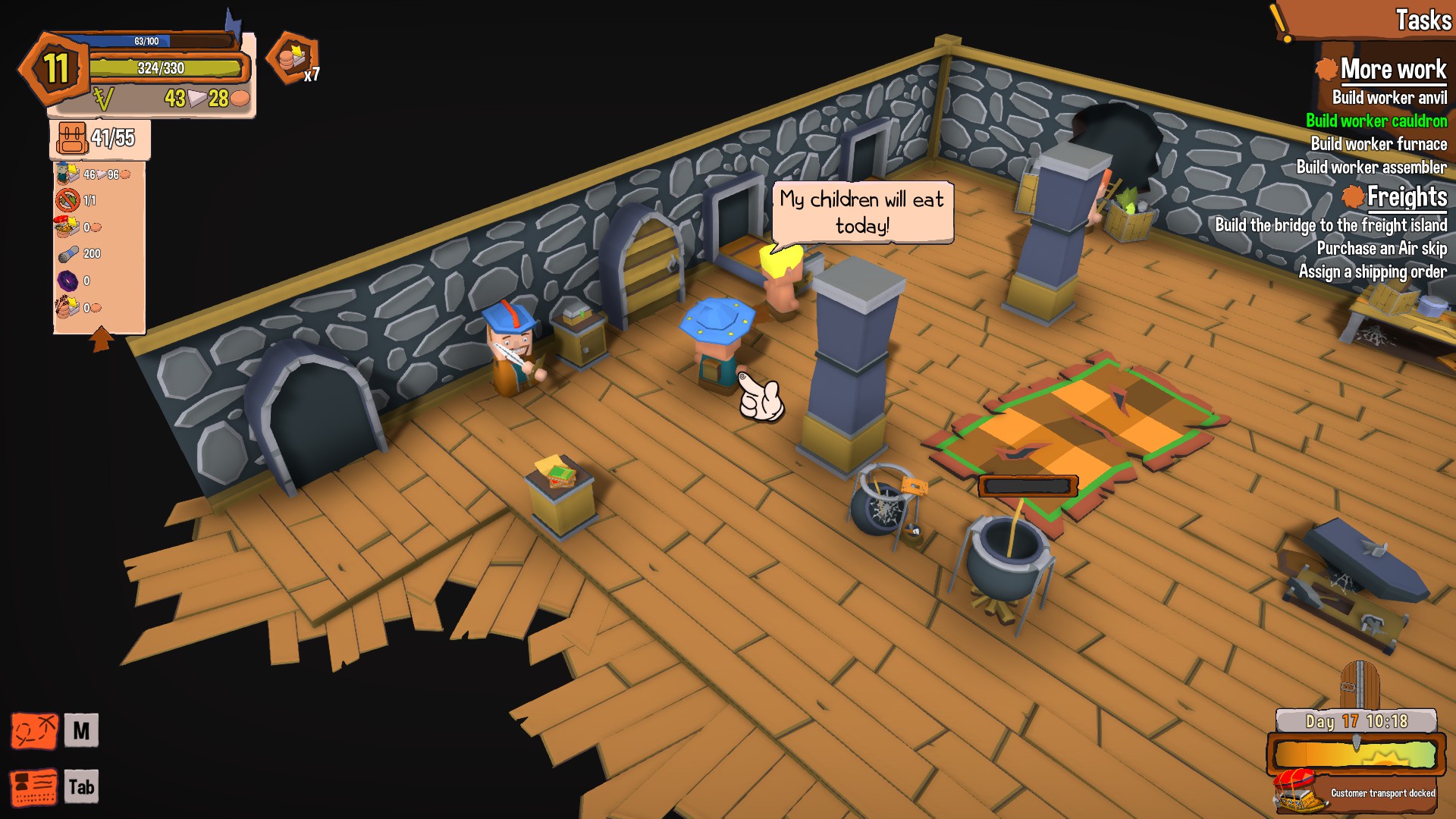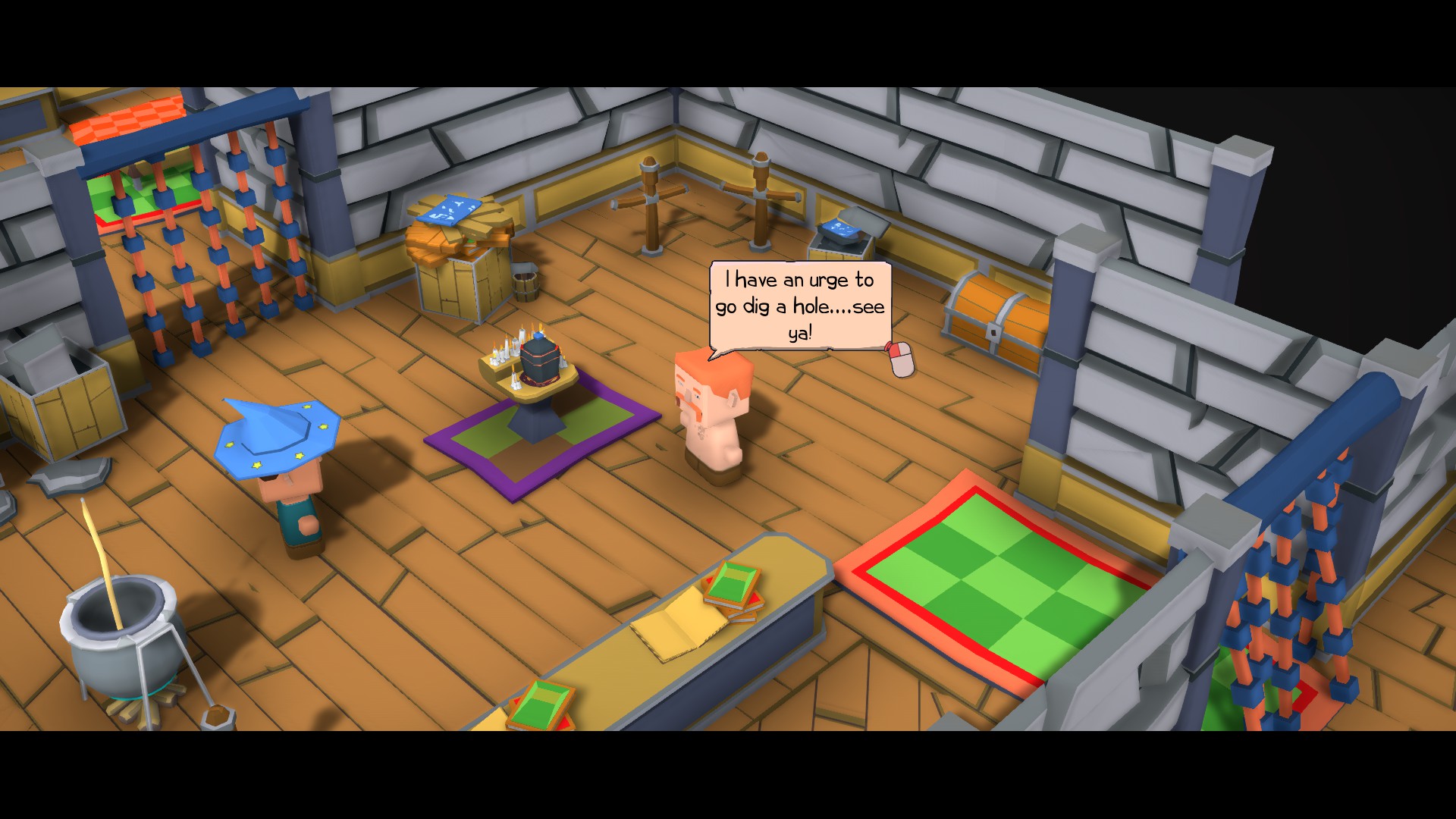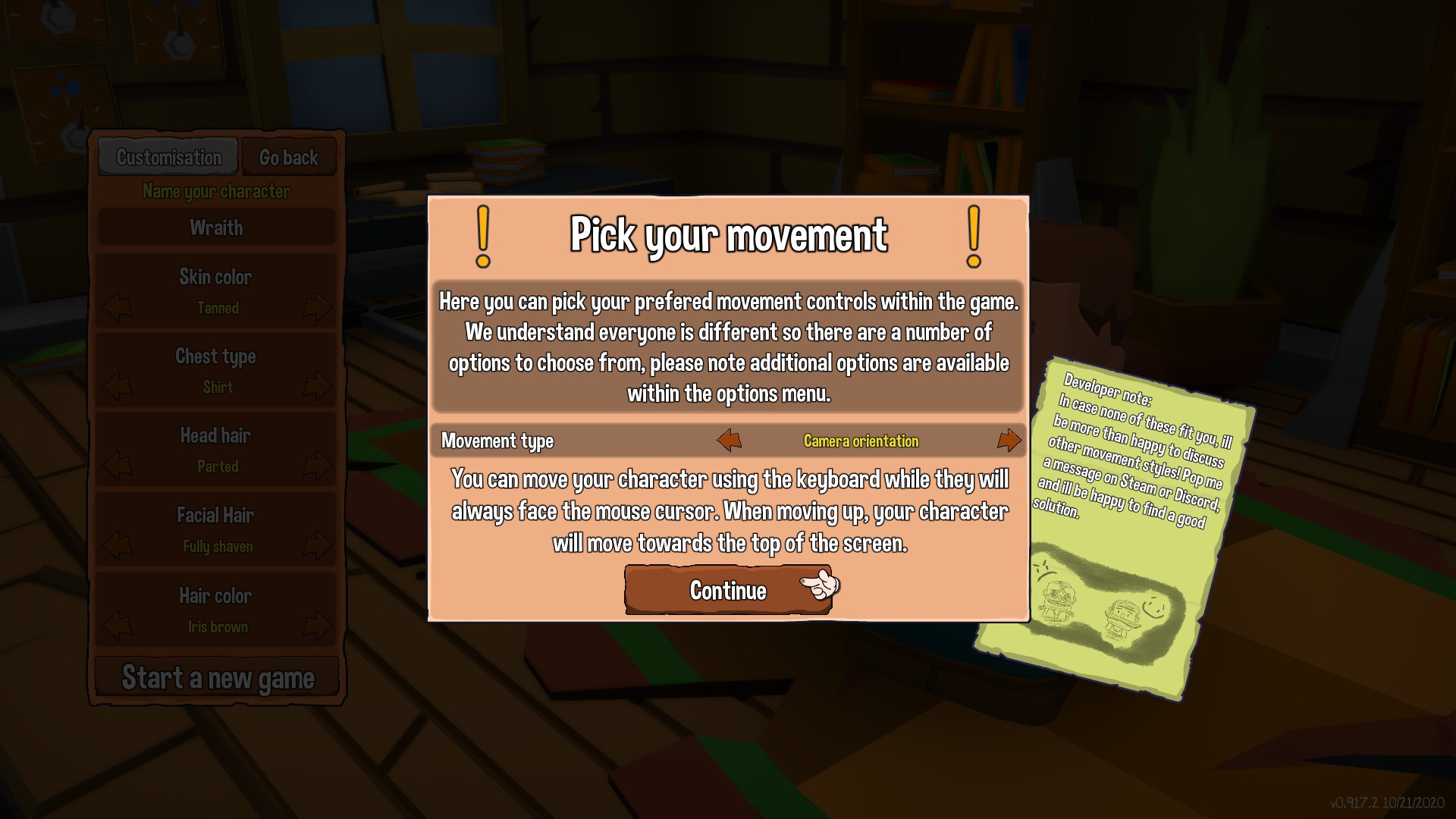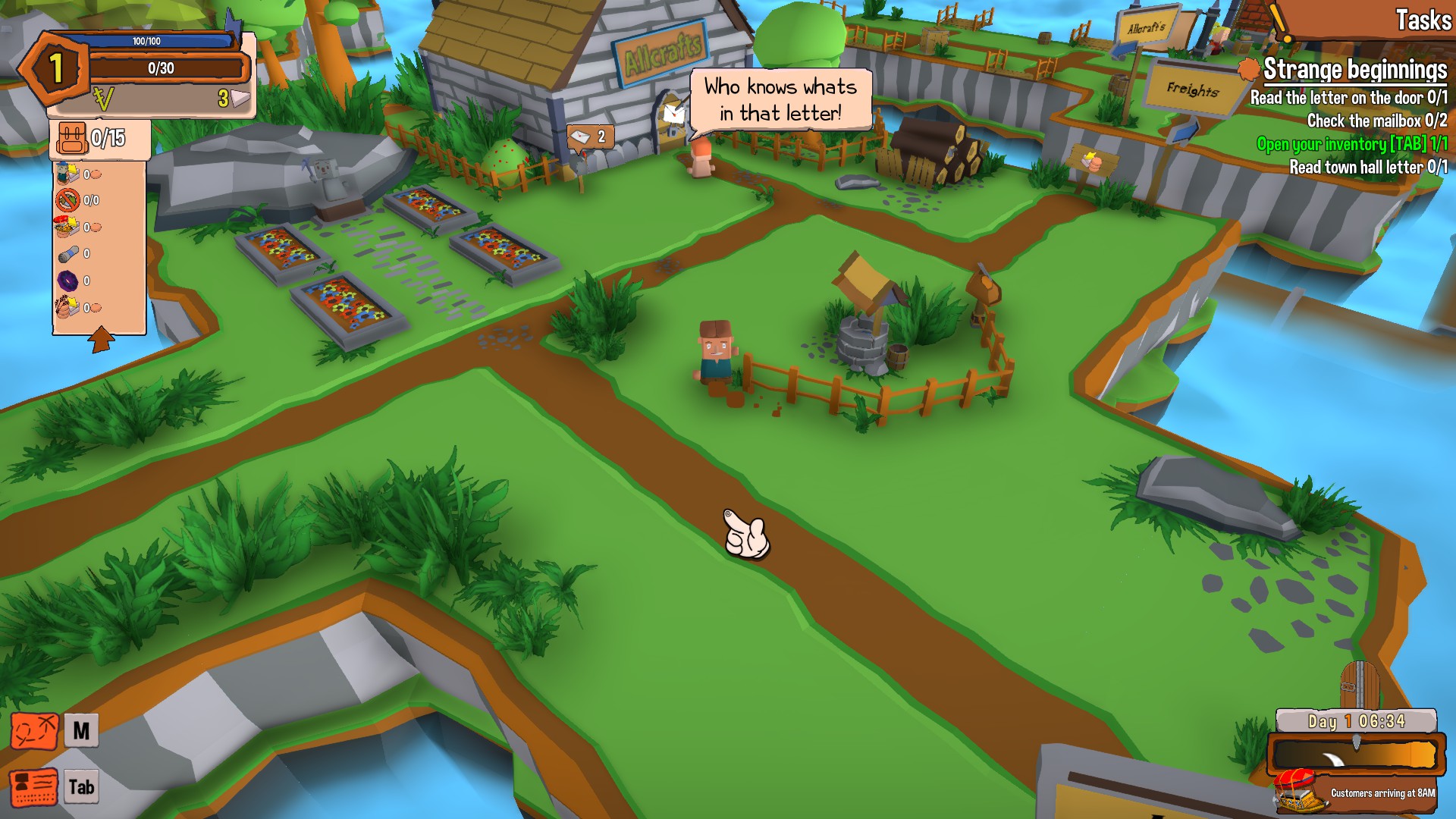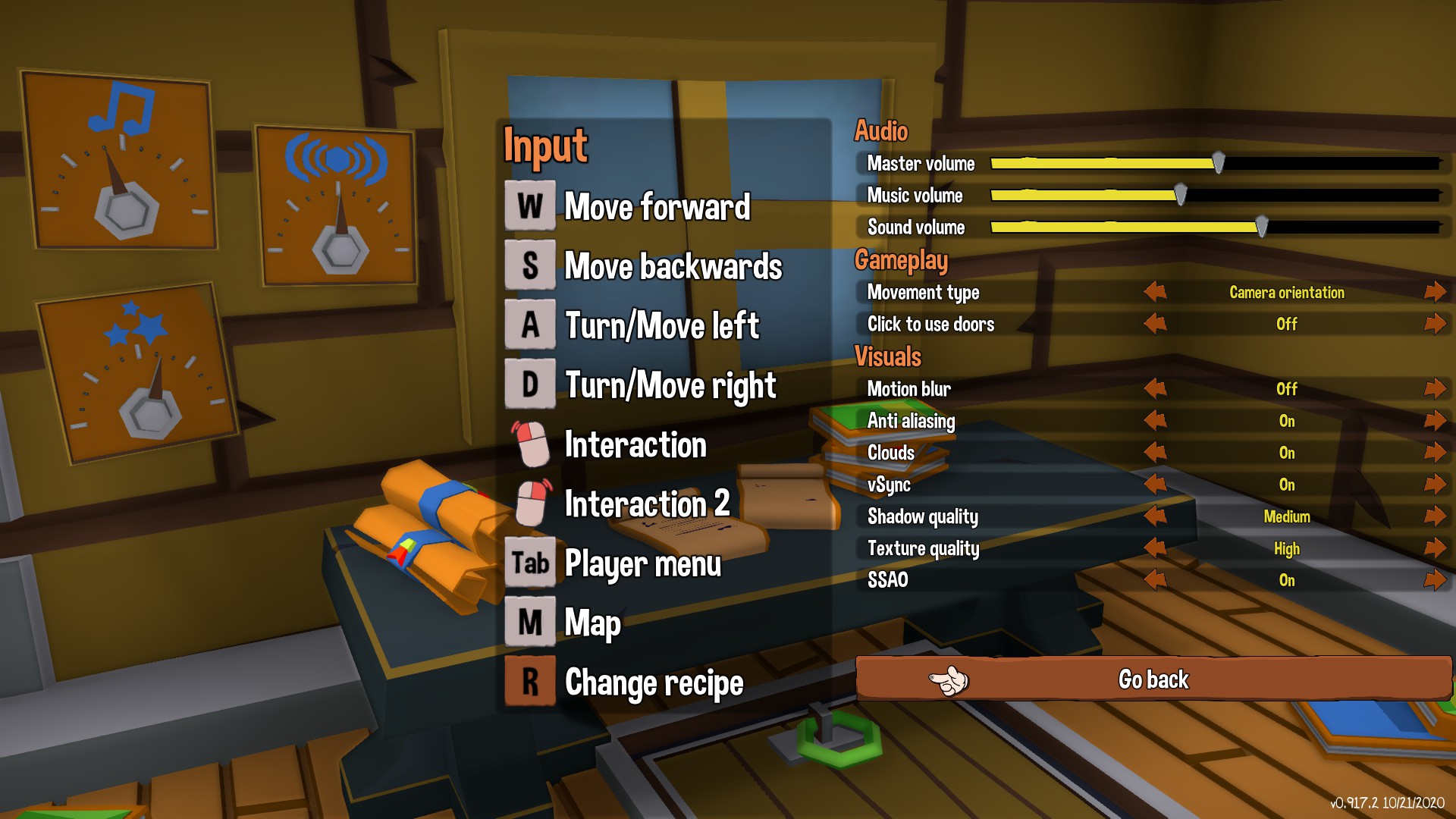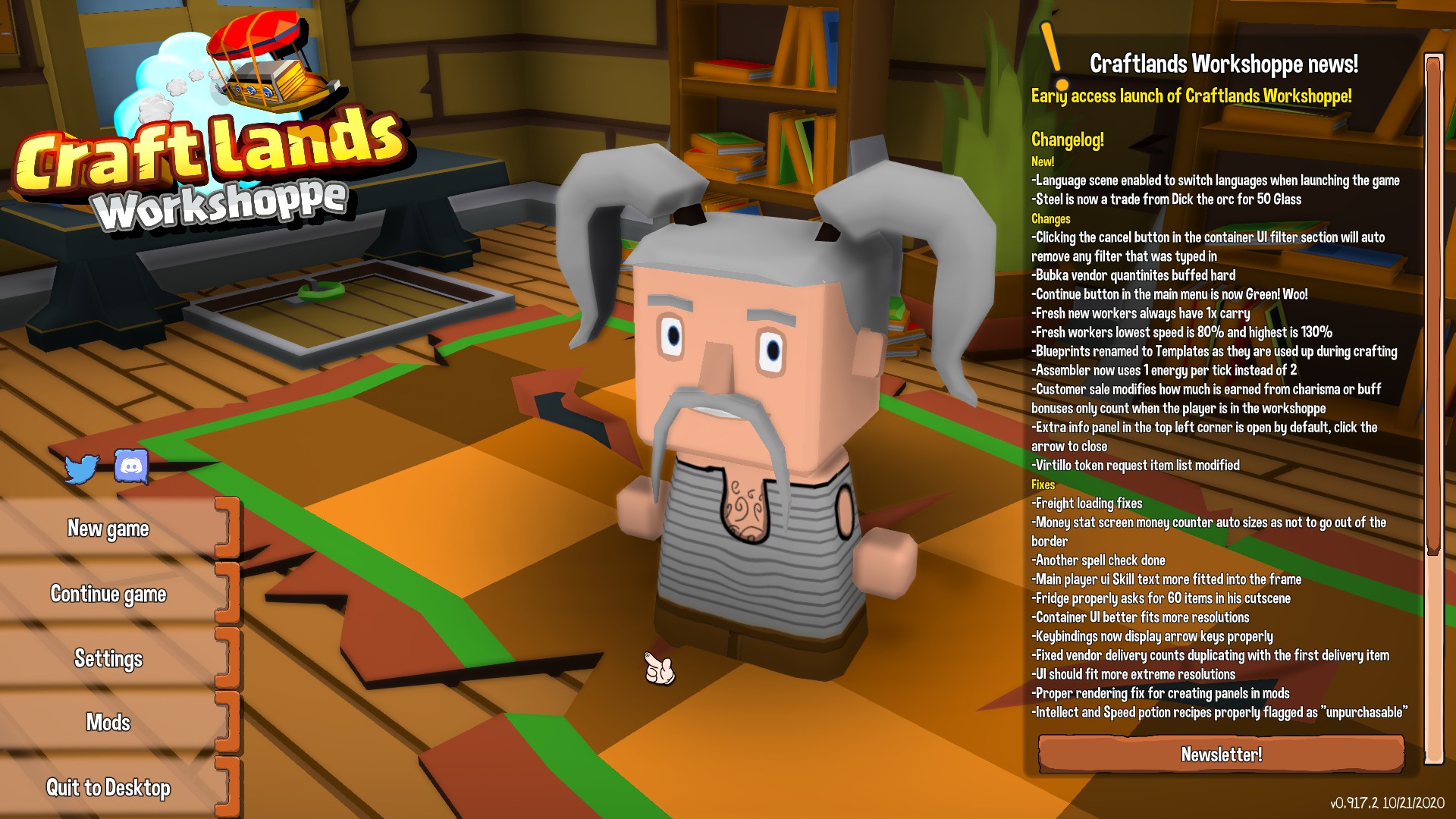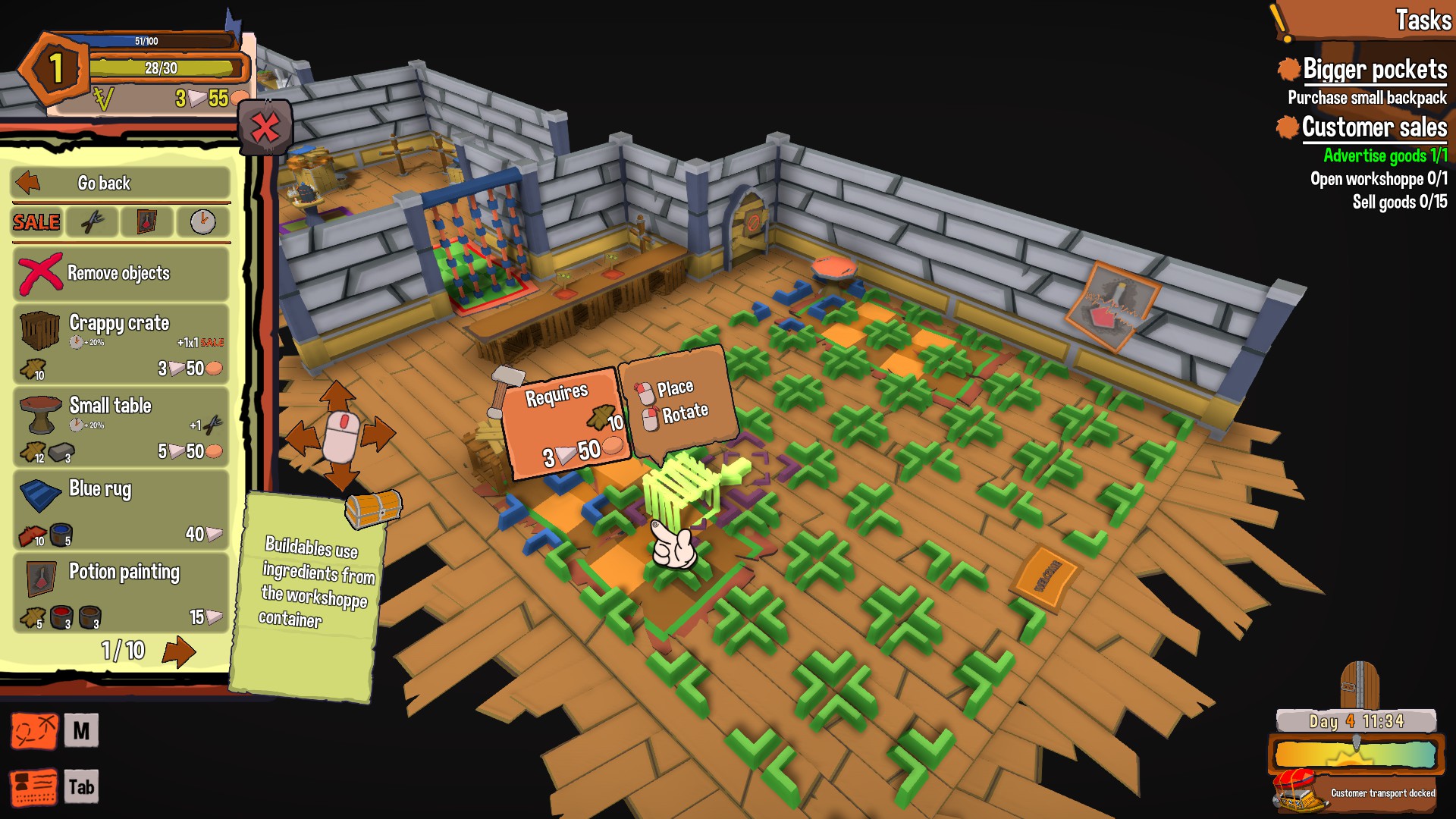Insufficient materials to craft this intro blurb.
Type: Single-player
Genre: Management, Sandbox,
Crafting
Developer: Arvydas Žemaitis
Publisher: Excalibur Games
Release date: 13 October, 2020


Intro
It’s an indie crafting-and-management game from a single developer! What, no, it’s not Stardew Valley, it’s Craftlands Workshoppe. Yes, with an “ye olde” -pe at the end. How’s it different from Stardew Valley or Rune Factory, then? Well, you do less farming (although there is some), but mainly, you do crafting and selling things in your workshop. No, it’s not Recettear, either. In those games, you get to have a combat portion of the game. So, it’s like Shoppe Keep, but with even more abstract graphics? Well, it’s apparently made by someone who worked on that, so yeah, it’s vaguely like that, but without the first-person combat portions… oh, and it has floating islands with airships, so that makes it different from all of those besides Rune Factory 4, I guess.
Feeding the Consumer
Your primary gameplay consists of gathering materials you can use to fill recipe requirements and craft stuff.
Further, very rarely (I mean 100 times you craft something rarely), you need to clean the workplace by holding down right click until the progress bar hits 100%. I’m not entirely sure why this exists. It’s rare enough that it keeps being a surprise when it happens, making me wonder why I’m not loading more food into the oven when I right-click a couple times at it. Combined with the problem that the mouse cursor can easily be completely over the left oven, yet still be ‘selecting’ the right oven, it can be a bit annoying at times. That said, the simple fact that the ovens allow for multi-tasking at all makes it one of the few crafting things where you can challenge yourself to juggle multiple stations going at a time, making it probably the best station to use.
Since the “mini-games” are so dead simple, they can make crafting of large quantities of goods rather boring at times. There’s also the issue that you don’t get to see how much inventory you have left in your inventory, just what you’re adding to your inventory as you craft, so unless you count out as you go, you can get surprised by running out of something. When crafting large quantities (especially in alchemy, which requires five containers per product in addition to whatever the ingredients were), you can also easily wind up needing to make multiple trips to the storage chest per run. Sorting inventory, gathering the prescribed materials, going back to brew more, dumping your supply off, getting more materials, brewing more, etc. makes for a dull loop.
You then go to the store portion of your shop and flog the merchandise to the consumerist cattle flock into the store. They mostly want whatever goods you “advertise” before opening the store to customers, which you can select from a tab in the inventory menu. Unlike real advertising, this is instantaneous and free.
Except between the hours of 11 PM and 8 AM, you will receive a continuous flood of customers asking for things from your advertised list, and willing to pay a notable (yet never directly stated) markup on the goods you are selling, unless sold from the displays. Customers can purchase from three locations in your customizable shop area:
The counter is a fairly simple way to sell products to people. They march up, have a speech bubble with an icon of what they want, and you can sell them goods by left-clicking, or tell them to leave (which has no repercussions because your store has no reputation to ruin) by right-clicking.
Customers at tables are served the same way, although you need to go out of your way to get to them, AND you need to clean up after them (taking up stamina and time by holding down right-click), however you get the significant bonus of keeping whatever container the goods came in. For alchemy, for example, you can make five protection potions from 2 pieces of iron that cost 5 copper each (or 2 copper per potion’s worth), but each potion needs a jar worth 1 silver, 38 copper. (This game goes by WoW currencies, so 1 gold = 100 silver = 10,000 copper. I’ll just refer to them as “cp” for their copper value from now on for clarity.) Getting the jar back to use again is massively beneficial to your profits with a potion like that (the sale price is , however other goods, like bread, take no container, so you’re adding in the effort of cleaning a table to get nothing back. Sadly, there’s no way to fold up your tables or set them back out when you need them – you destroy and have to rebuild tables from scratch…
Finally, displays like the crates with the potion or mug of ale at the bottom of the picture above let you put an item onto the display via menu, and customers that purchased other goods will go and buy from the displays as well. Customers pay less for these (75% of base price), but there is the advantage of selling any item you have on the display, giving you a chance to clear out inventory you don’t have in enough quantity to be worth advertising.
Selling things tends to be mostly busywork. Somewhat like Diner Dash, but without the need to actually grab things related to your order, you just run up to characters and click on them. As you add more tables and get more customers in, you can make things more frantic for yourself trying to hit every customer in time, but there’s no penalty for failure, so… enh, take it easy, unless you care about the time. It feels like a major missed opportunity that there’s so little actual gameplay in this portion of the game, but hey, I guess since you can automate it later on by getting someone else to serve customers for you, it has to be mindless…
After all this, you need to go buy more goods to start the grind all over again, hopefully at least somewhat wealthier than the last loop.
Every type of product has a set number you need to make and sell yourself to “master” before you can get your workers to make more of them for you. Likewise, you have a separate skill/leveling meter for each of the crafting types, and leveling each up gives you new recipes, although some recipes require special unlocks that involve “buying” them with large quantities of other products.
As time goes on, you gain unlocks for other aspects of the game, like a farm to grow your own ingredients for cooking or potions, a resource gathering site, and “Freights”, which is sending large quantities of products to other sky islands as a means of performing bulk sales.
You can eventually skip the sales portion of the game entirely by getting a ghost license and letting ghosts run the register while the shop is open. No idea why the living workers can only produce goods and the dead can only sell them, but hey, that’s how this game runs.
Time, Why You Punish Me?
While I readily admit this may affect me more than other gamers, playing a lot of time-management games has made me extremely nervous whenever the game clock is running in a game that actively tracks time like Craftlands. In a game like Rune Factory 4, for example, getting all your daily chores like watering plants and brushing cows done quickly gives you more time in the rest of the day to go to dungeons and kill bosses for rare material drops. Hence, I memorized the shortest paths and always pause the game by going to the menu whenever I am trying to think of what I should do next.
Craftlands, however, only pauses in the escape menu. Ever. In a shop, in the purchasing menu? Time is running. Talking to an NPC? Time is running. In your inventory? Time is running. Reading the help menu or tutorial stuff? Time is running.
Time runs fast in this game, as well, at a rate of about 1 real second = 2 game minutes.
Further, stamina drains at a pretty alarming rate whether you are running or just standing around. Unlike other games like Harvest Moon, you don’t collapse at 0 stamina, but you’re unable to take any actions that require stamina. Still, it’s hugely annoying to see that just reading through a basic conversation with an NPC that is trying to explain things like the reason why you’re all on floating islands takes 6-7% of your stamina bar and a game hour.
This drives me batty, and just leaves me unable to relax. I can’t stop to read anything unless I’m going to force-quit out of the game to reset, or I’m losing time. This makes an interface that can be confusing because of vague instructions even worse at times, because I feel the need to skim the already sparse tutorials just to keep time loss to a minimum.
I left a message on the forums about this, and the developer said that he never designed the game with pausing in mind, and that trying to add it in (which he’d tried to do earlier, possibly because other players reacted as I did), he said that doing so “broke so many things in the game” that he decided not to do so. It’s a real pity, and I hope there’s a change of heart on this subject, or at least some sort of modding capacity for slowing down time like there was in Stardew Valley, because being unable to get home before 7 AM just drives me nuts, and adds a serious element of stress to a game that on paper should be fairly relaxing. It actively makes me enjoy the game a lot less.
One major element is that sleeping in the bed gives you 100 stamina, and saves your game, but advances time to next 7 AM, whether you hit the “totally sure” button at 6:59 AM or 7:01 AM. (>OF COURSE the game doesn’t pause in this dialogue option!) Because of this and the way that customers will arrive at 8 AM, it pays to spend the nights crafting, hit the bed at 6:45 AM, and then prepare for business early in the morning… although I often go several days between selling sessions, just because a trip to pick up supplies takes half a day, and crafting enough goods to be worthwhile can take a day and a half.
When you’re simply on your own, granted, time doesn’t seem to mean much but how much the day counter goes up (although why show us the inevitable march of time if it isn’t a core gameplay element?), but when you get employees, they continue to burn through your money constantly even when they sit back and complain they’re out of materials to work with.
The Ploys Employees Employ
At a certain point, you gain the ability to hire employees that can make goods you’ve already “mastered” by making and selling a sufficient quantity of, yourself.
Virtually everything about these employees is highly random to the point that it unbalances the game greatly, and they’re one of the largest complaints among the players on the forums. Workers can charge between 5 and 20 silver a day while the 5 silver a day worker works at 110% speed and the 20 silver a day worker works at 90% speed.
To make matters worse, every time they “level up” by working long enough, they can get one of two perks that also gives them a raise.
One player commented that they got a negative perk that dropped work speed that came with a pay cut that actually dropped the worker’s pay to just a handful of coppers per day, making them automatically the best worker they could hire just because even slow work is worth it when it’s basically free. The perceived value of many of these perks is just ludicrous, and clearly needs to be based upon something that makes prices sane, like tying raises to a percentage increase in the pay you already give them based upon the actual percentage increase in performance. Others, like the “get more money when selling to Timmy” perk pictured above lack critical information you need to make a sane choice – how can we tell whether spending 25 silver a day is worthwhile when we don’t know HOW MUCH MORE money they will get when selling to Timmy?
I think it’s worth stating as a rule, however, that there’s something strange about saying that automation “makes a game too easy”. By definition, automation takes no skill, so if it makes money at all, it will make infinite money with no player skill involved. The balancing going on is just a matter of how much luck it takes to get a stable loop that pays for itself.
Rather, it’s a great thing to automate the boring parts of the game, but you should make sure that the rest of the game includes the interesting bits. Either you need a Factorio-style loop where constantly designing increased automation is the main gameplay loop, and the automation just takes care of the details for you, or you need to have constant shifts in the game for the player to alter the automation to account for, such as gradual expansion of certain markets in games like Patrician.
Hence, I find the time and effort put into balancing the automation to be “challenging” to be wasting effort on something conceptually wrong to start with.
The Jokes
They’re pretty lame. Even for someone who makes a Hootie and the Blowfish lyrics reference and thinks it’s a “witty” segment header, these are pretty lame jokes.
Compared to a series like the fantastic Gust Atelier games that feature humor, yet also personable characters with compelling emotional arcs in spite of their goofball natures, Craftlands starts off with some naked guy digging in the bushes screaming “TIMMEH!” and generally encourages you not to care about any of the characters. This deflates most of the jokes, because there’s no tension because you really don’t care what happens to any of those characters. Oh, there’s tentacles coming from a portal somewhere? It’d be so sad if the crapsack world became slightly more crappy!
Interface – Information Displayed
To start with, the tutorials are often being too short to really explain everything in the game and there is no way to review them if you missed something or accidentally double-clicked through an important part of the tutorial outside of restarting without saving to see it again. I had to restart when I didn’t notice the way to open the shop was the tab in the player menu when I accidentally double-clicked through the tutorial. I looked all around the shop after the tutorial to find some interactable object that would open the shop. Similarly, I had to ask on the forums how you’re supposed to remove weeds from the farm, because there is no hoe or sickle like most farming games. Instead, you need to buy “potions of failure” and use them on the weeds to clear the land. There is no tutorial that describes this, and no tooltip describing what the potions of failures do.
Likewise, you are constantly shown two different prices for every object. One is a “base value” for an item, but then there’s another price that someone will actually pay if they buy from you or you buy from them.
You need to make goods in large batches to tread water above your operating costs like workers, but you are constantly running into problems of your limited inventory meaning that you need to make constant trips back to your inventory chest. The inventory chest itself has a search function, but again, time doesn’t stop when you try to use it. You constantly need to run out shopping for bulk orders of things, and you want to buy more than you can carry just to cut down on the number of needless trips back to the shops, that are often a full minute’s walk away. However, there’s only an indication of how much you already own in your current inventory, not your store inventory (and you can’t even see the worker’s basement inventory unless you’re at that chest, either), so you have to either write things down on a physical shopping list, or else buy more than you need and hope for the best. After several trips, I often forget how much of any leftover goods I have, and get confused, especially when buying separately for the shop inventory and worker’s basement inventory. I really wish there was a display you could see while shopping about what quantity of each item you have in each container.
Another problem (sadly common to many management games) is that a graph displaying information on income and exepnses exist, but they lack the kind of detailed breakdown that would be necessary to actually help the player make informed decisions. The game has no employee breakdown at all, for example, so there is no real way to tell whether any given employee is carrying their weight or not without manually standing over their shoulder for a day to watch their income and expenses before save-scumming by force-quitting and reloading. This sort of thing shouldn’t be necessary to get basic information on how your business operates!
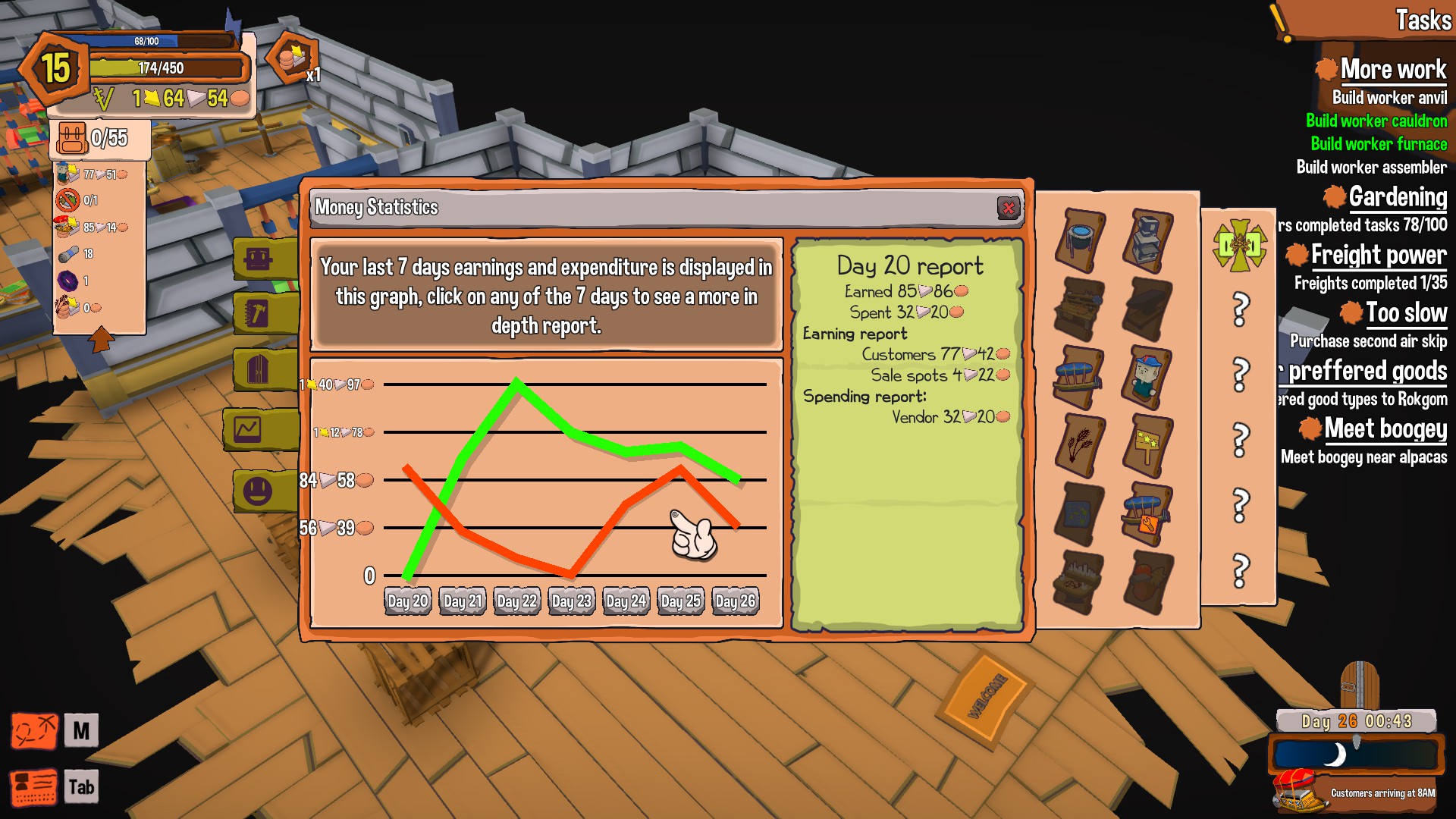
Interface – Controls
When you start the game, you unusually get a choice of about a half-dozen different control schemes for how the keys move you. I can only assume this is because the developer prefers some odd setup where you face the mouse pointer and A and D strafe when you hit them, and all the players complained.
This sort of control scheme makes sense in a third-person action RPG or rogue-lite where you have ranged attacks, such as Diablo or even Stardew Valley if you’re using the slingshot, but since there is no combat here, it makes little sense not to just go with a tried-and-true “face the object you want to use” system.
One huge gripe I have is with the mouseover often selecting the wrong thing. This is a constant problem with, for example, the ovens while cooking, as they are next to one another, or the worker manager who stands right next to the worker pay box. A particularly galling example is in the controls menu, itself, as the selection zone for rebinding keys is so large that it bleeds over to the other half of the screen!
In a game where time is continually flowing and you’re trying to micromanage, having selection boxes so large they cover up nearby objects so you can’t click on what you’re pointing at makes a stressful time-management game even more stressful for no good reason.
You do have the ability to rebind keys, and unlike Port Royale 4, this means rebinding all the keys, not hiding a few crucial ones you can’t rebind for no good reason. That said, there are a lot of controls bound to specific contexts that, if they are left- or right-click by default, cannot be changed without changing all left-click actions. Especially with the mouseover selecting the wrong things, this can sometimes result in doing the wrong thing because you’re not selecting what you think you selected.
Sound
The game plays what appears to be a single music soundtrack at basically all times, being an acoustic guitar plucking with some instrument-less melody in the background. It’s so far in the background that I could easily ignore it, but before long, you’ll probably want to start playing your own music.
Sound effects are generally a lot of “splat” sounds. They do the job, although they don’t really make me feel like I want to live in this kind of world any more than the humor does.
All told, they’re not what you’re here for, yet they’re not going to detract from your gameplay enjoyment, which is as good as you can hope for from most single-developer indie games. Just play your own music and move on.
Graphics, Customization, and Randomized Characters
Using a simple, cartoony cell-shaded aesthetic in a game apparently made by a single developer is a good choice just on the basis of making a game that is at least presentable as a 3d without game without needing to either use pre-made assets or take up tons of developer time. That said, as someone who’s played a lot of these sorts of at times pastel, goofy management games, Craftlands still feels not nearly as colorful or cartoony as the other colorful, cartooy games. There’s a desaturated look to everything.
And that’s of course before you get to the randomized characters that the game throws at you (including employees and customers you cannot customize, unlike your own character)…
The game only has a half-dozen settings for each customizable part of a character, and there is only one single torso “piece” with no color choice. The “shirt” choice, for example, is a teal-colored shirt. There is exactly one feminine torso, a red dress with heavy cleavage showing. Characters have no genders, they just pick pieces randomly, so you can have a gray-haired character with double bun hairdo, a goatee, and a significant bust hanging out of a red dress.
Hopefully, with time, there will be some expansion of the choices, especially including the likes of simply palette-swapping what color shirt you wear, so I’m not too hung up on it, but with customization being a major theme, it does feel a little disappointing that it’s so minimal.
Customization also plays a part in your workshop, where you can add rugs or paintings to the place. Rugs come in different colors, but they each require their own recipe to do so. I really wish there were something more like Terraria’s dying system, where you can make a base item, and then color it separately. It greatly expands the ways in which you can genuinely customize your house when you have what amounts to separate textures and colors.
Verdict
Craftlands is filled with annoying niggles that could be fixed eventually, but if you are the sort that enjoys crafting and selling purely for its own sake, this may interest you. That said, many of the game systems feel a bit on the shallow end, and I would have greatly appreciated a crafting system with mini-games that were more enjoyable in their own right.
Farming, for example, is literally just putting seeds on dirt and coming by every few days to gather the results. There’s not even the trivial water can exercise in Harvest Moon games, much less anything like Rune Factory 4’s soil fertility system to play with. Most of the craft games are just holding down right-click and waiting. Games like Yohoho! Puzzle Pirates introduces a new mini-game that is fun to play in its own right for every job you have to perform, so you can play a Bejewelled clone while pumping bilge on your pirate ship. That makes a game all about mini-games fun. This is a game with nothing but the sheer amount of micromanagement and multi-tasking to distract you from the fact it’s all about making money and filling up progress bars.

